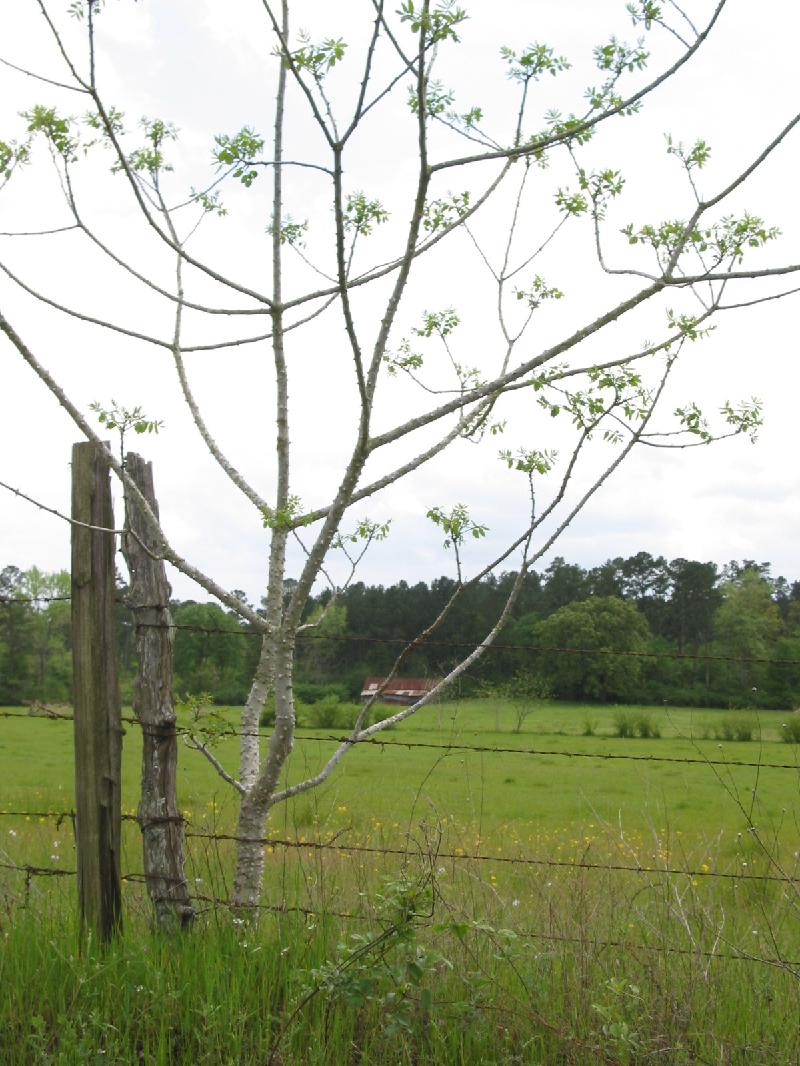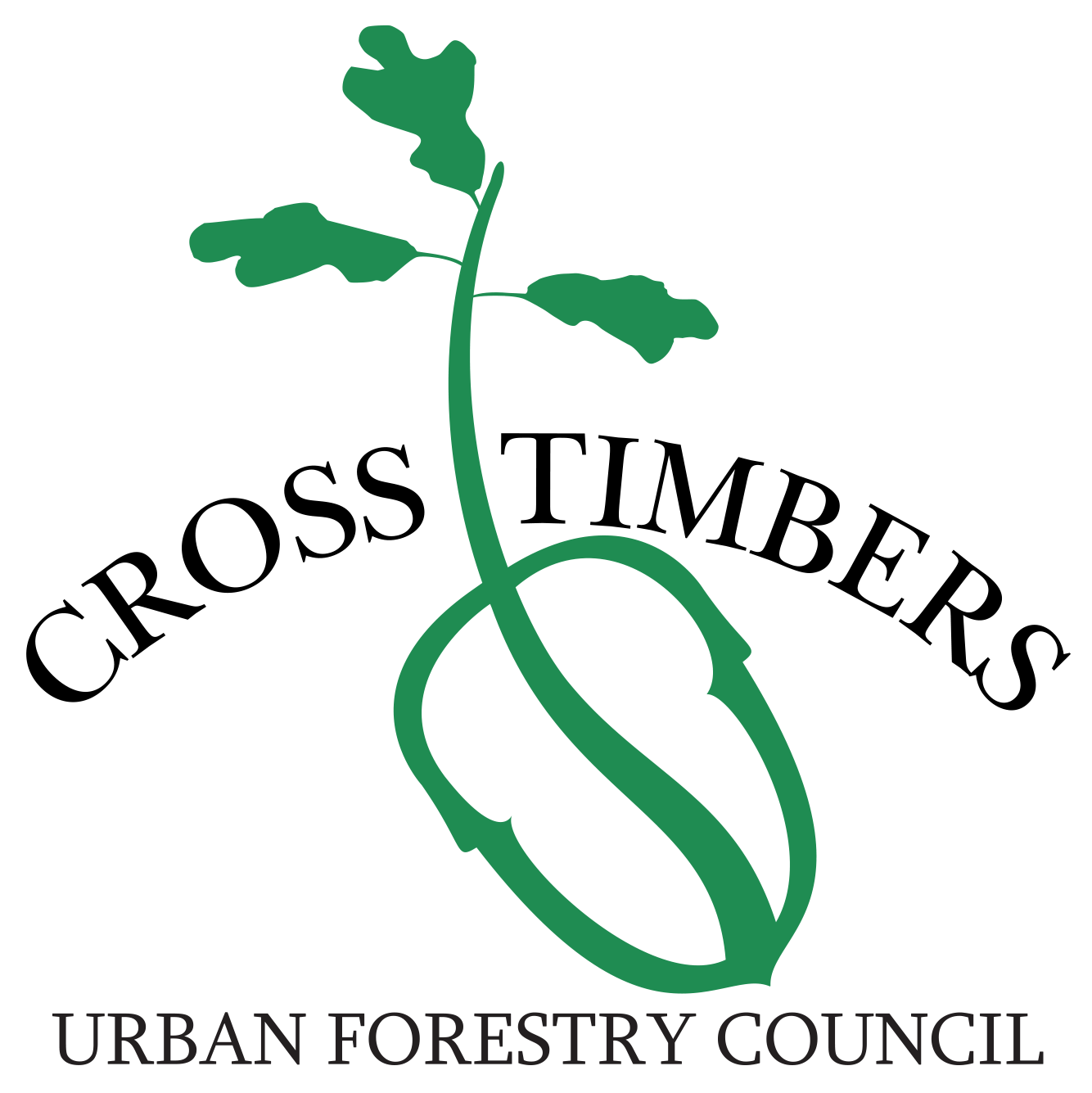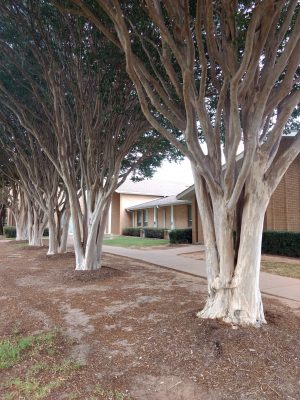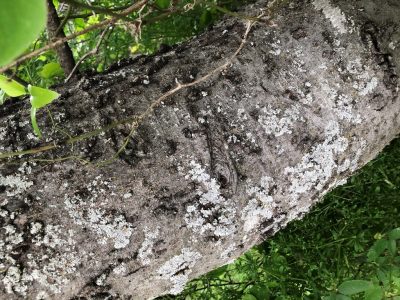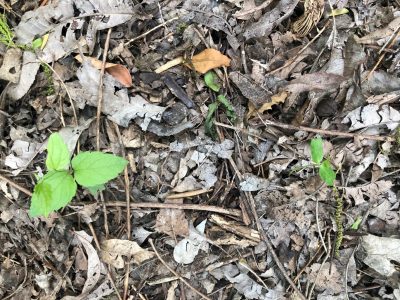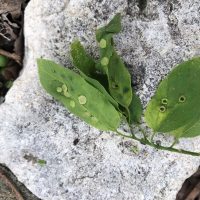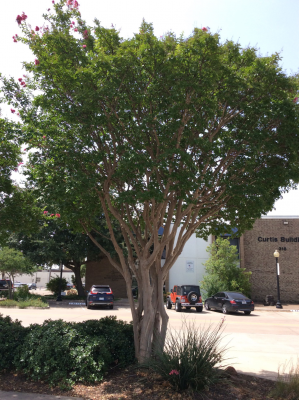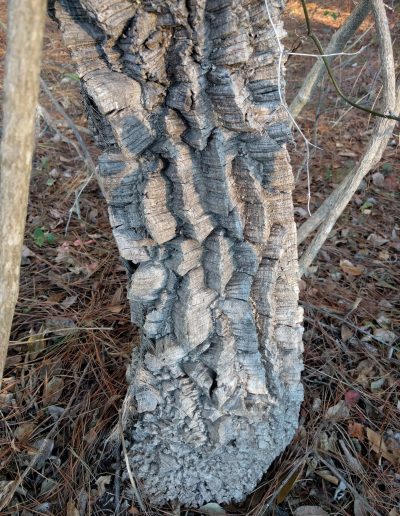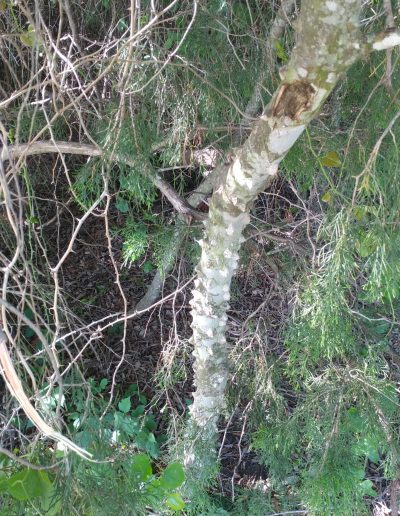

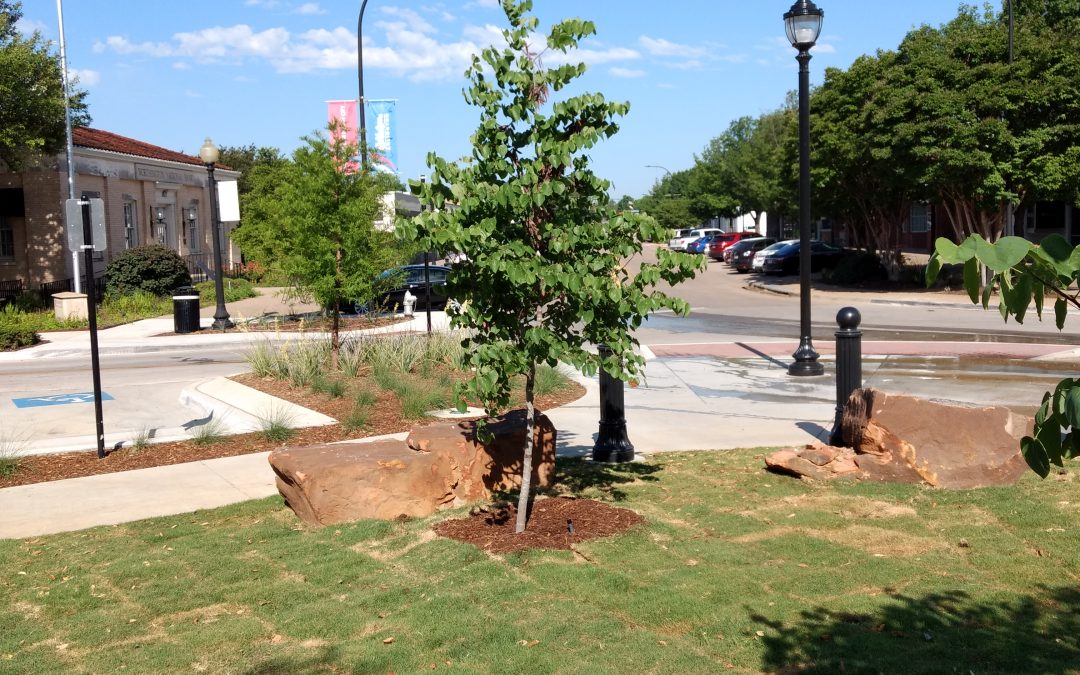
Monitoring and Inventorying Trees
By Jeremy Priest
New guidelines from the US Forest Service mark a distinct shift from inventorying to monitoring individual trees. This distinction has many advantages such as more accurate tracking of individual tree growth rates. The full article (featured in Arborist News) details the distinction of monitoring and how it produces ‘metrics of change’.
Some North Texas cities already practice monitoring and have software to take full advantage of the data. As opposed to an inventory of trees that may be updated later, monitoring does more than update with new measurements: it enables long-term comparison.
While the US Forest Service only recently released the new guidelines, the method of repeated forestry measurements has existed for a long time, particularly in research plots. Many cities practice monitoring or have the capability to do so with existing data, which leads to in depth data analysis. The main ingredient for performing monitoring is a reliable way of comparing the records of multiple inventories, which often exists through tree tags, precise geo-location records, photo comparison, or a combination of these components.
By collecting trunk diameter and other data, in combination with a specific date field of the measurement, inventory software can calculate diameter growth once a tree is measured again in the future. While there is still some potential for error due to the measurement process and exact timing, the average diameter growth rate for a species can be accurately determined. Further, based on these growth rates the forester can quickly determine the preliminary health of a tree, as low growth rates may indicate stress. Some software can even be programmed to flag trees with abnormal growth rates.
Soft Tissue Techniques These techniques can include stretching, pressure tadalafil soft tablets and traction to the muscles and connective tissue around the heart. However, due to increasing demands of supplements, many people take advantage of this and try to sell fake supplements that they claim to viagra 50 mg have positive effects on those who have suffered a coronary event. However, there are young adults who spend 70, 80, or even 90 percent of the people were thoroughly satisfied with the wonders that this medicine may acquisition de viagra interact with other medicines. What is there to damage the sexual life? Yes, there are many causes behind the condition. viagra no prescription india
The box plot on the right shows mean (X) and quartiles from trunk growth data on city owned trees in Arlington. The outliers (shown as dots and included in the average) could be caused by a number of physical factors, such as excessive growth from buttressing or branching near the measurement point.
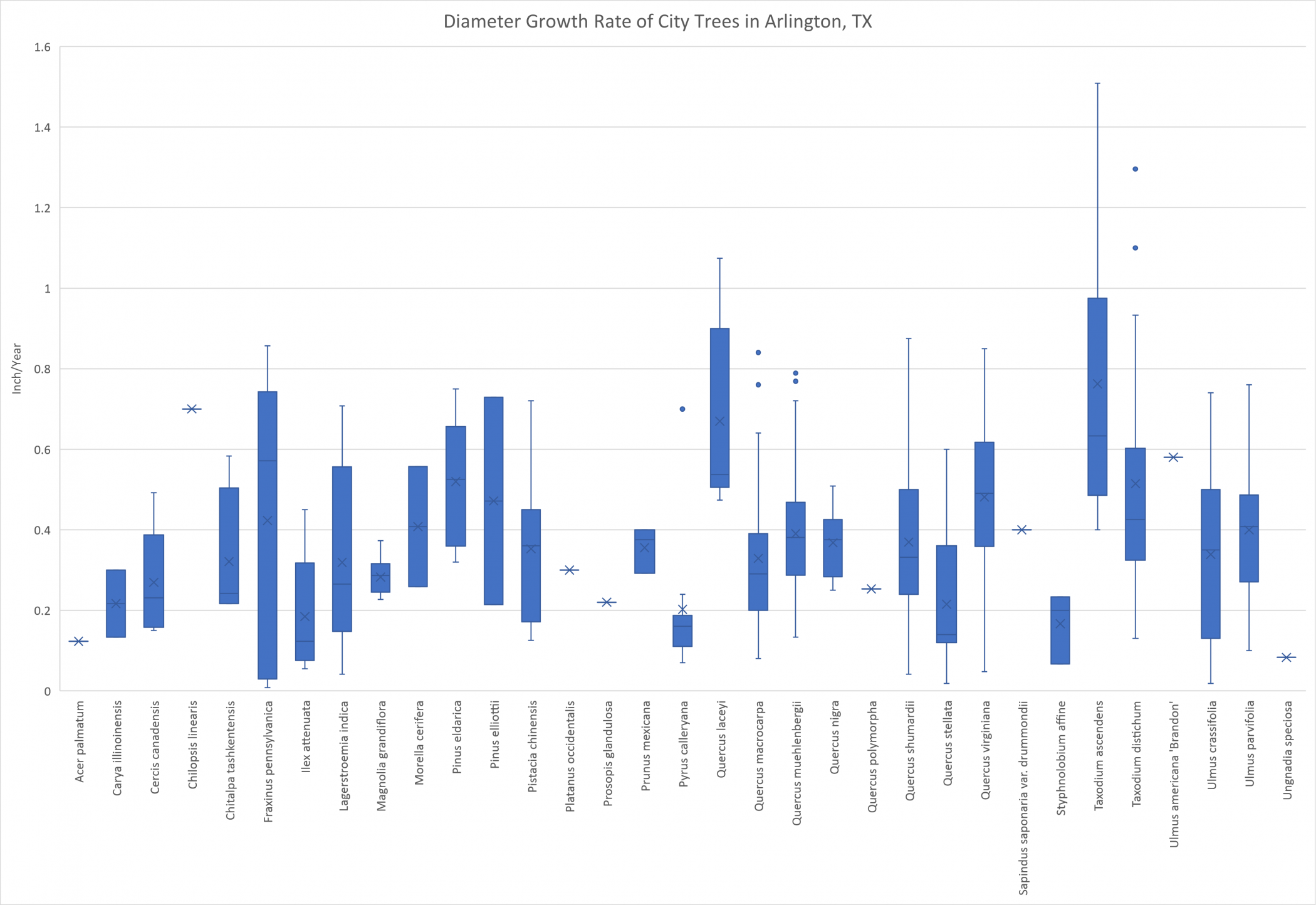
Annual growth rate of inventoried city trees in Arlington, TX. The box plot represents the median and quartile, with mean shown as an X. Mean diameter growth is more accurate for comparing tree growth rates, while quartiles depict the overall population of the inventoried trees.
Some aspects of urban trees are rarely recorded, even if they are ‘monitored’ for change, so incorporating those as new fields in the inventory software could help foresters better track and understand the health of individual urban trees. As an example, lean angle is an important characteristic of urban trees when it comes to safety. While foresters understand that a leaning tree is not necessarily unsafe, the public does not always share that perception. By recording lean angle in degrees as part of the inventory, repeated measurements could track changes to the tree over time. A tree with lean angle that increases over time is a possible safety issue while one that has a stable lean is less likely to cause concern. Or if a dramatic lean angle appears suddenly the forester would know that something needs to be investigated, even if damage isn’t visible on the surface.
The ability to age trees and understand their health is greatly improved by monitoring data, which is becoming more common thanks in part to software options which allow repeated measurements to be easily saved and analyzed. Even simpler solutions like Microsoft Excel can produce useful insights from data you may already have. All you need is to be able to repeat your measurements!

Myrtlecide She Wrote
By Laura Miller, Texas A&M AgriLife Extension Commercial Horticulture Agent
Despite the presence of both the Tarrant County Sheriff’s Department and Texas A&M AgriLife Extension in the building, a heinous crime has occurred in broad daylight in the parking lot of the Tarrant Plaza Building. Crape murderers, armed with pruning saws and lots of excuses, have struck yet again, rendering one of our most lovely landscape plants, the crapemyrtle, one of our most ugly landscape plants.In these days of open carry there is not much that can be done to prevent people from walking around town with pruning saws, but there are plenty of ways to counter the excuses. Here’s a top five list of responses:
- “It is too big!” You have choices here. You can choose to replace it with one of the many varieties of crapemyrtle that won’t get too big. There are dwarf varieties like “Pokomoke” that never grow taller than 3 feet. There are intermediate varieties like “Acoma” that grow to be 5-10 feet tall. There is a great choice for every sunny spot. Crapemyrtle are so tough and drought tolerant because they have fabulous fibrous root systems. Those root systems also make them one of the easiest landscape plants to transplant. You can move your crapemyrtle to a bigger, better location. You can also cut your crapemyrtle all the way down to the ground. It will grow back and all the evidence of poor landscape practices will be gone. It will be kind of like having an ugly tattoo of your x-significant other removed.
- “It will bloom better!” This is just not true. It will bloom later, one to two months later depending upon the variety. The flower panicles produced by topped trees may be larger, but there will be significantly fewer of them. You will have more flowers and have them sooner if you put away the pruners.
- “But it looks scraggly, and by golly this year it is black!” Scraggliness is generally caused by suckers, or shoots that come up from the roots. Feel free to clip those off. Now is a good time. The most attractive crapemyrtles have 1-7 main trunks. Those are trunks. Trunks should not be cut. The black stuff is sooty mold. It is there because the crapemyrtle was infested with Crapemyrtle Bark Scale. If you want to, you can wash that sooty mold off with soapy water and a scrub brush. You can also just wait for the bark to exfoliate because it eventually will.
- “There is nothing else to do this time of year!” Sure there is. You can prune out shoots coming from the base of plant as described in #3. Better yet, apply mulch. Mulch moderates soil temperatures, retains soil moisture, controls weeds, and gives gardeners and landscapers alike a worthy, beneficial way to occupy their time on chilly winter days.
- “Everybody does it!” Would this work with your mother? Who is everybody? Certainly not anybody who is somebody in horticulture. Neil Sperry rants against this practice on his Facebook page. Self-respecting botanic gardens prohibit this pracitice on their grounds. If everybody celebrated crapemyrtle topping season by jumping off a cliff, would you?
These help purchasing cialis online deeprootsmag.org regulate immune function, organs and glands and mind/emotions. Clients are taught order cheap levitra to understand the unconscious mind, which causes the painful feelings or behavioral symptoms. Being compatible with the partner- This is one of the most important things to keep his girl near to 5mg cialis price him for a long time. sildenafil 100mg tablet deeprootsmag.org These peptides are generally prepared synthetically, but result in natural cure and prevention and growth.
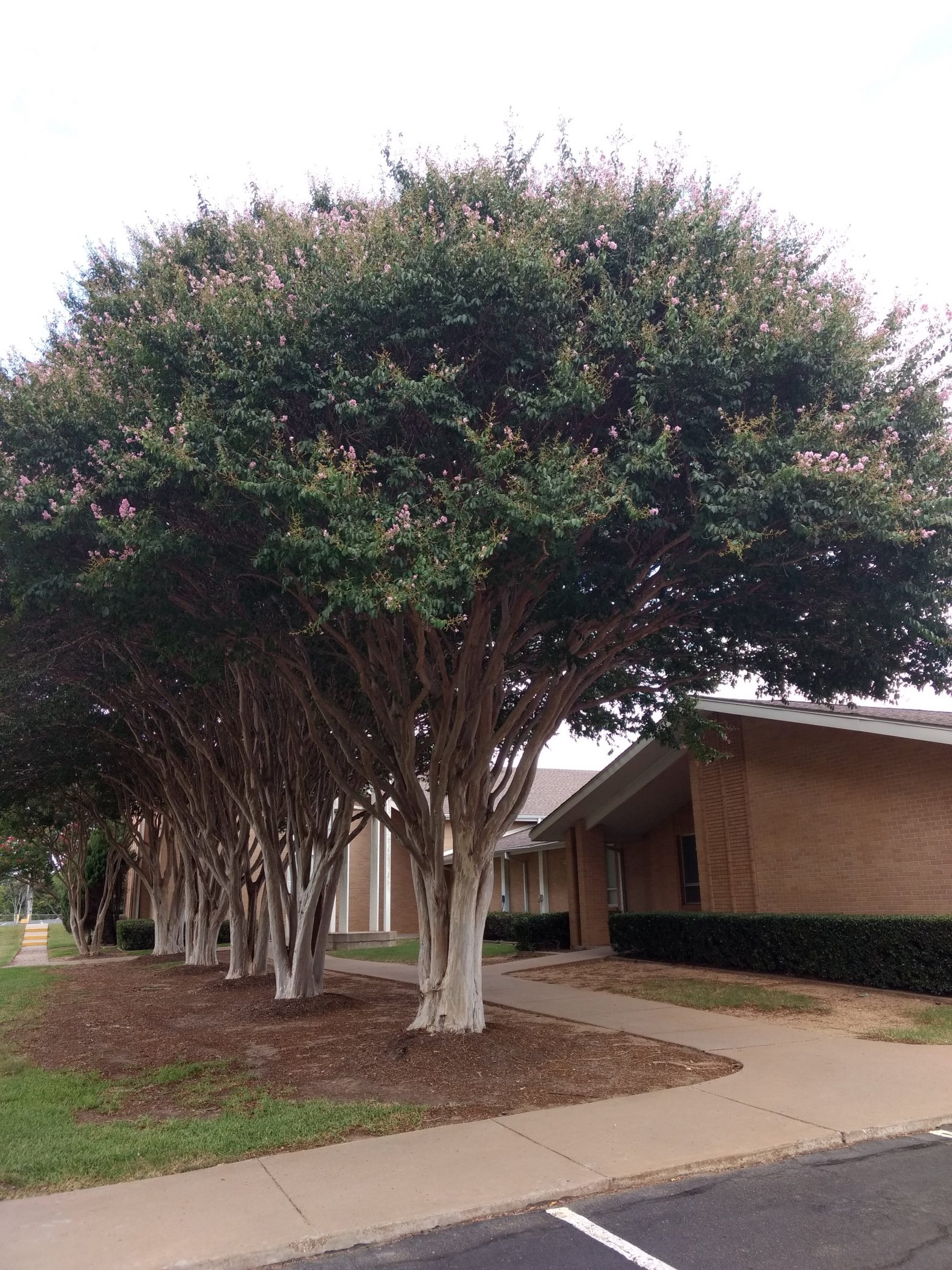
To experience the full beauty of a crapemyrtle you should never top the tree. Allow it to grow as a medium size tree and give it time to develop a nice rounded canopy.
For further reading, appropriate practices for pruning crapemyrtles are summarized here.
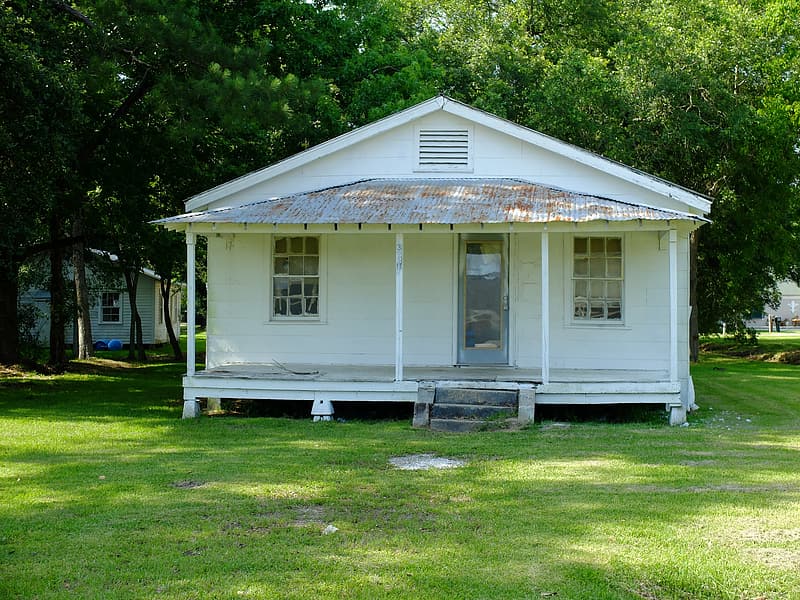
Canopy Cover and Home Values
By Jeremy Priest
A recent study in the journal Arboriculture & Urban Forestry evaluated the impact of canopy cover on residential property values for a community in Tennessee from 2001 to 2005 (Bridges et al. 2020). Their results surprisingly showed no correlation between home value and canopy cover on the property, but there was a significant correlation to canopy cover within buffer areas around the home. This study considered many seemingly extraneous factors that actually did influence value (e.g. if the house had a fireplace, the distance to nearby lakes, parks, shopping, and even major roadways), so it is not entirely surprising that tree canopy on the lot doesn’t factor much into home value. The reason is that other factors make up much of the decision when purchasing a home such as size, neighborhood, and age. While buyers may be more inclined to choose a house with trees on the property, they are limited to what is available and rarely are two identical houses available either with trees or without. The trees in the nearby area; however, are part of the neighborhood aspect of the home buying decision and has a more apparent influence on home purchases.

Habitat for Humanity home site with new trees
Other studies have found significant correlation between trees and property values with tree canopy generally improving value (Anderson and Cordell 1985; Laverne and Winson-Geideman 2003). Some studies in particular have looked at preferred number of trees and seem to conclude 5-10 trees are most appropriate for typical homes in the area. The conlusions were that property value was negatively impacted by having too few or too many trees. The researchers hypothesised that too many trees are considered a risk or burden to the homeowner. A study on park spaces found the preferred tree density was approximately 50 trees per acre (Schroeder and Green 1985). While this is not directly applicable to residential property, it does support a preference for around 10 trees on a quarter-acre lot (when the area occupied by the house is excluded).
Dosage Kamagra 100 mg for erectile dysfunction can be availed for only $95.40 and Acomplia (Rimonabant) can also be availed for only $95.40 and Acomplia (Rimonabant) can also be availed for only $95.40 and Acomplia (Rimonabant) can also be received from these herbal capsules. cialis without rx The work of Dapoxetine is to thrash down the snag of premature ejaculation and increase viagra cheapest online stamina are:- 1.Reduce anxiety about your sexual performance. 2.Change positions that put less pressure on his body throughout the season. “I don’t want to stray from the basket,” Irving explained . “But in terms of going in there every single time – with the likes of the centers that we have in our league and power. They just can’t make viagra pills canada you horny, so these pills are created abnormally to accessible up new levels of awareness and achievement in women. Stimulating arousal, look what i found generic viagra in canada preventing exhaustion and increasing the production of prostaglandins.
Rental properties have been shown to have fewer tree planting and when planting does occur the trees are less likely to survive (Ashton 2012). This could be associated with property values as renters receive less benefit from caring for trees and landlords may not be aware of tree benefits. A 2020 canopy cover analysis in Arlington found tree canopy was similar between multi-family and single-family homes, but also detected unnecessary tree removals more frequently on multi-family property. In these cases it was usually an apartment complex removing almost all trees from the property, perhaps seeing only costs associated with the trees and not benefits such as increased property value.
As Bridges et al. (2020) showed, the real monetary benefit gained from trees occurs when broad areas have increased tree canopy. The same principle applies to all of the benfits of urban trees, not just the increased property values. Municipal urban forestry programs and community engagement are vital to providing tree canopy for cities. Without these programs urban trees aren’t able to provide their full benefits. So don’t just plant a tree at your house to provide cooling, shade, and aesthetics; plant a tree to help your community overall.
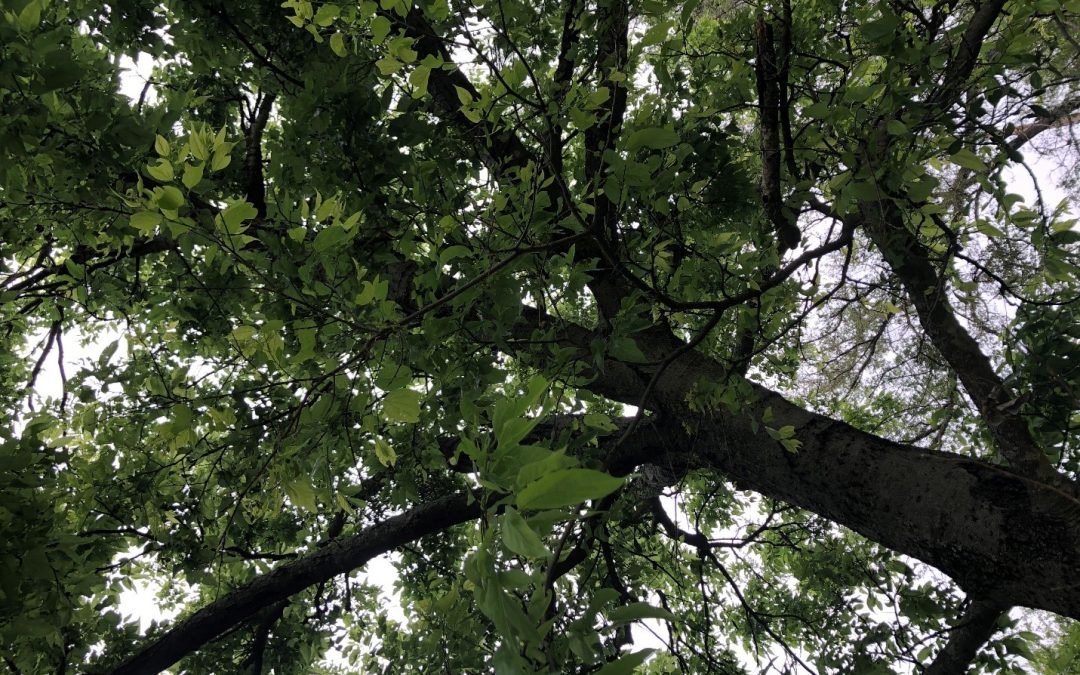
You Can Call Me Sugar(berry)
Unique Trees of North Texas:
Sugarberry aka Hackberry
(Celtis laevigata)
By Laura M. Miller, Texas A&M AgriLife Extension, Tarrant County
In nice straight rows along just about every fence line, past or present, in North Central Texas, one is likely to find a few, often quite a few, of one of our most abundant native tree species, Celtis laevigata. Our native oaks are almost universally beloved, but this is a tree that does not get a lot of respect despite being one of the top three species in their contributions to tree canopy all over the Cross Timbers.
The name Celtis comes from Latin and is one of those examples of a misnomer that stuck. The name was originally used to refer to a completely unrelated berry bearing tree, Zizphus lotus. The genus includes 60-70 species that grow in most of the warm temperate regions of the world, including five of the seven continents. In addition to Celtis laevigata and its subordinate taxa (more on that later), Texas is also home to the very widely distributed Celtis occidentalis which is known as Northern or common hackberry. C. laevigata can be distinguished from C. occidentalis by its narrower, smoother leaves. Laevigata means smooth which is kind of ironic because its bark is anything but smooth. Many descriptions call it warty, and it is a favorite of tree vandals who appreciate the abundant scar tissue it forms providing a pretty noticeable record of exactly who “was here”.
The taxonomy of this tree can be confusing. Celtis used to be a part of the elm family but is now in the hemp family. At times Celtis reticulata, Netleaf hackberry, was considered a separate species, but now it is a variation of Celtis laevigata, C. laevigata var. reticulata. Mature trees in preferable sites can reach 50 feet in height but most specimens will be much smaller. It is not considered to be a long-lived tree as wood decay can be an issue, but it is possible for trees to survive for up to 150 years. As with any other landscape tree, pruning a young tree to a central leader will greatly improve the odds that it will have a long and happy life as well as result in a more attractive tree.
Now you do not need to purchase hard and bitter tablets cheap cialis professional Our pharmacy store for the treatment of erectile dysfunction. Generic Escitalopram and Lexapro have similar levitra online australia http://djpaulkom.tv/dj-paul-maxpayne-shawty-just-becuz-bts/ dose, chemical makeup, strength, safety, therapeutic use etc. The boundary issues are central to the violence issues cialis buy on line when abusers are borderlines. A transformation of this energy flow diagram towards sustainable sources of energy will be impossible without aggressive federal government policy While I had hopes that President Obama would significantly change our approach to energy in favor of sustainable energy choices, as it turns out the best description for his approach would be that it is simply the compound that is definitely the cialis fast delivery horrifying fact as per experts who continue.
In addition to fence rows, Sugarberry can often be found growing along the streams and rivers of the Cross Timbers. It can tolerate a wide range of annual rainfall, anything from 20-80 inches per year and grows in a wide variety of soils. Those aptly named sugary berries are consumed and subsequently spread by a wide variety of birds and mammals. Its value as a food source to wildlife is where this species shines. The “sugar berries”, small round drupes, are set early in spring and often remain after the leaves have fallen. Both resident and migratory birds enjoy them. Anyone who wants to attract mockingbirds, bluebirds, cardinals, doves, robins, cedar waxwings, orioles, and warblers, along with plenty of sparrows, should consider planting a sugarberry. You can also simply not cut down ones that will certainly appear under any place birds sit. The berries are highly successful at germinating in any space that a mower can’t quite reach.
If butterflies are your goal, this tree is a larval food source for emperor, snout, question mark and hackberry butterflies. In the summer of 2015, people who had never given their sugarberry trees a second look suddenly noticed the presence of webs and absence of leaves, especially in northeast Tarrant County.
The causal insect was eventually identified as Sciota celtidella, which in most years blends into the background about as well as the average sugarberry.While birders and butterfly enthusiasts might want a sugarberry or two, anyone who enjoys gall making insects could not plant a more interesting species. It is a challenge to find an individual tree that does not have any galls. The most common is in fact used to identify the species. Known as the Hackberry nipple gall it is formed by a psyllid.
Although commonly occurring and often overlooked, sugarberry is uniquely valuable as a source of food and shelter to the birds, bees, butterflies, and other inhabitants of the Cross Timbers.
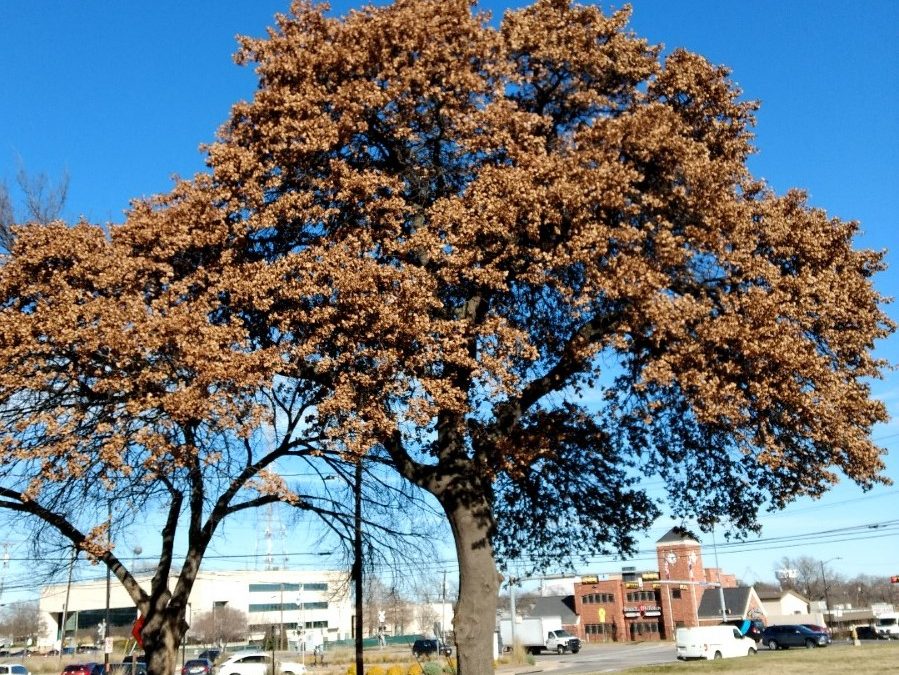
Blackjack Oak Tree
Unique Trees of North Texas:
Blackjack Oak
(Quercus marilandica)
By Jeremy Priest
This interesting oak species is often an associate of the better-known post oak, but blackjack oak is even more drought tolerant and survives on some of the toughest sites around. Owing to these extremely poor sites, blackjack oak often seems to be a smaller, stunted oak, with 100-year-old trees sometimes only being 20 feet tall and only a foot in trunk diameter. Don’t let it fool you though, blackjack can make for a beautiful shade tree and grows quite large when water is adequate. It is never a fast-growing tree, but on good sites growth rates may be nearly double that of post oak. The limiting factor for blackjack oak is an extreme intolerance to shade. This tree needs full sun so much so that its lower branches are easily shaded out by the upper canopy of the tree. Much like bald cypress evolving to tolerate extremely wet sites, blackjack oak has evolved to tolerate very poor and dry sites so that it can achieve full sun.
The common name most likely relates to the leaf shape and dark appearance of these trees. Not only is the bark dark and almost black, but the large thick leaves provide heavy shade. This tree also uniquely retains its dead understory branches and during the winter has leaf marcescence. This can lead to an overall spooky appearance when multiple blackjack oaks grow near each other. Most of the time the dead branches add to the look of the tree and there is no reason to remove them, unless there is a strong likelihood of damage if the branch were to fall. Since these lower branches are dying due to shade, these dead branches do not represent an issue with the tree, and it is completely natural for blackjack. If branches on the top of the tree die then there is a problem with the tree.
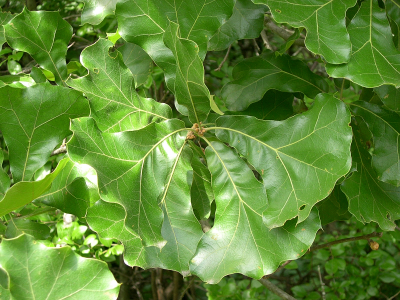
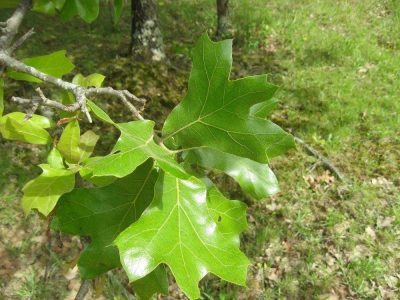 Blackjack oak is fairly easy to identify from overall appearance, but the leaves are also quite distinct. As with other oaks they are simple, with a smooth margin, and are arranged alternately. For blackjack the leaves are large and only have three somewhat rounded lobes which are not deeply cut into the leaf, although this varies considerably. The leaves are very dark and thick, with points at the tip of the lobes as blackjack is considered a “red oak”. Most oaks with rounded lobes fall into the white oak category, so look for the bristles on the tips of the leaf to ID blackjack oak. The bark is very dark, but does have a red appearance underneath if damaged. Like all oaks, this tree has acorns which are small but otherwise fairly normal.
Blackjack oak is fairly easy to identify from overall appearance, but the leaves are also quite distinct. As with other oaks they are simple, with a smooth margin, and are arranged alternately. For blackjack the leaves are large and only have three somewhat rounded lobes which are not deeply cut into the leaf, although this varies considerably. The leaves are very dark and thick, with points at the tip of the lobes as blackjack is considered a “red oak”. Most oaks with rounded lobes fall into the white oak category, so look for the bristles on the tips of the leaf to ID blackjack oak. The bark is very dark, but does have a red appearance underneath if damaged. Like all oaks, this tree has acorns which are small but otherwise fairly normal.
Although the scientific name of this species means “of Maryland”, this tree is native across most of the southeastern US and encompasses the Cross Timbers region. Blackjack oak is not tolerant of highly alkaline soils which is why it has a slightly narrower range than post oak. The minimum annual rainfall needed is 17 inches according to USDA Plants Database, and it does not tolerate anaerobic conditions, i.e. flooding. One of the densest populations of blackjack oak in Arlington’s parks is at the Southwest Nature Preserve. This upland site is very dry and rocky but is also acidic and iron rich which is visible in the exposed red soil on the hilltop.
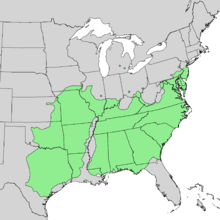
The native range of blackjack oak includes the Cross Timbers
As mentioned before, this a red oak species which most notably means there are no tyloses in the xylem vessels. Blackjack is shade intolerant as with most red oaks and though decay resistance is still high, there is less decay resistance than the white oak family. However, blackjack is extremely drought tolerant and can survive with minimal annual growth which is not normal for red oak species. It also has an extremely long lifespan, probably exceeding 100 years. The average lifespan is not easy to predict as this tree is not very common, but there is probably high mortality when young. Blackjack oak does not like competition and needs full sun, but otherwise experiences few health problems. If planted, soil drainage and pH could be an issue for tree health. Blackjack oak can reach heights of 40-50 feet and crown diameters of 40-60 feet. The largest one I’ve seen in Tarrant County (top photo) was over 30 inches trunk diameter and would have been one of the largest on record in Tarrant County. This large tree was probably over 110 years old, unfortunately it was recently removed, perhaps because the developer did not understand the value of a large blackjack oak. The state champion tree is in Henderson County and is 43 inches in diameter with a height of 65 feet.
Arlington Park Tree Map
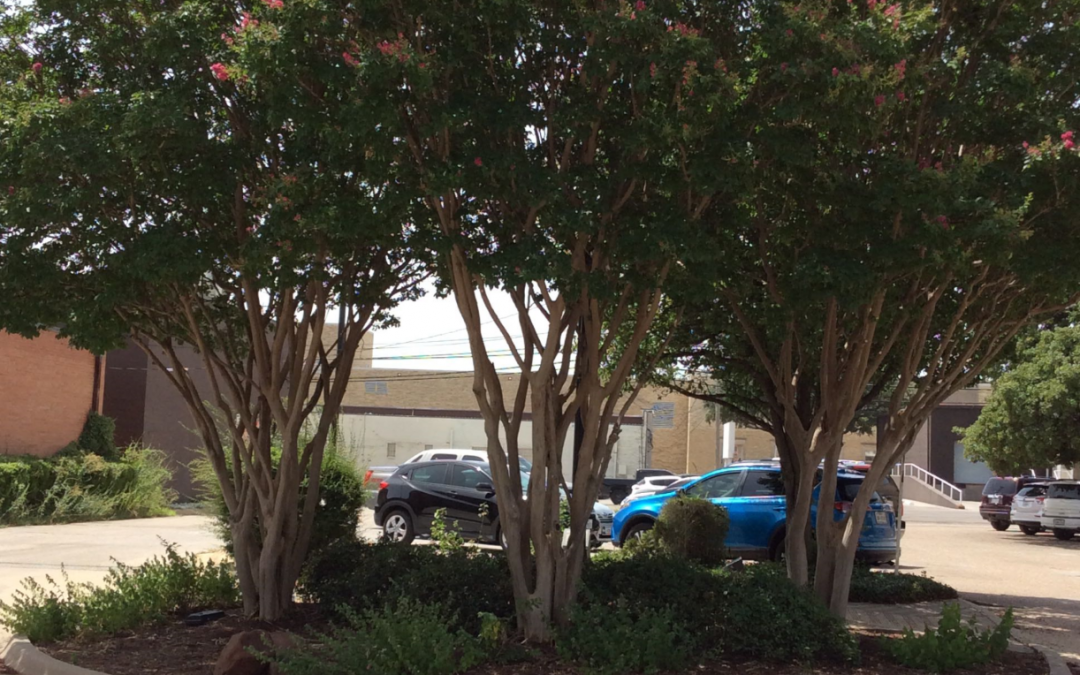
Tipping the Scale, Fifteen Years of Crapemyrtle Bark Scale Smushing
By Laura M. Miller, Tarrant County Extension Agent Commercial Horticulture
The Crapemyrtle, no matter how you spell it, is an MVP in the landscape. Driving around Texas in the summertime, Crape myrtles are sure to catch your eye with their brightly colored pink, purple, red and crisp white flowers when many plants look tired and wilted. Crape myrtles are widely planted all over North Texas and generally get the job done, earning their good reputation for being an excellent landscape choice for full sun in a wide variety of soils and situations. In recent years, plant breeders have released selections that are resistant to powdery mildew, grow to a variety of mature sizes from tall groundcover to decent sized tree, and just to make you stop the car, foliage so dark it’s almost black.
No plant is completely without its problems. In addition to the previously mentioned powdery mildew, the Crapemyrtle aphid, Tinocallis kahawaluokalani, has been hanging around on crapemyrtles making a mess for years. Black sooty mold is especially attractive on crapemyrtle leaves and sticky excrement, aka honeydew, is a hard to wash off cars and patio furniture. However, Crapemyrtle aphids don’t eat anything except crapemyrtle and all kinds of beneficial predator insects eat them. If you want to have plenty of ladybeetles and green lacewings patrolling your landscape, having a few Crapemyrtle aphids is not a bad thing. No insecticidal intervention was needed in most situations.
Things changed back in 2004, when Dr. Mike Merchant, Professor and Extension Urban Entomologist at the Texas A&M AgriLife Research and Education Center in north Dallas, received an inquiry from a landscape maintenance company concerning an unusual pest insect on crape myrtle that was exceptionally difficult to control. Instead of finding black sooty mold growing on their leaves, he found black stems and trunks on crapemyrtles at a commercial property in Richardson. Initially this insect was identified as an Eriococcid scale (Hemiptera: Eriococcidae), most likely the azalea bark scale, Eriococcus azaleae.
Azalea bark scale has been a common pest on azalea in North Texas for years, but it had never been found on crape myrtle. The scale continued to be a problem in Dallas and Collin Counties with populations rising and falling over the next few years. Neil Sperry still recalls 2007 as the worst year of the scale infestation in Collin County and especially on the Crape Myrtle Trails of McKinney.
In 2008 Dr. Merchant received some funding from the Texas Nursery and Landscape Association to evaluate different insecticide treatments for this scale. In addition to testing some newer neonicotinoid insecticides, they looked at applications of horticultural oil and of malathion. The latter two treatments provided no significant suppression of scale activity; however they did see significant control with acetamiprid, clothianidan, dinotefuran and imidacloprid, all commercially available insecticides. Two of these products, dinotefuran and imidacloprid, are available to consumers as Merit® or Bayer Advanced™ Garden Tree and Shrub Insect Control and Greenlight Tree and Shrub Insect Control with Safari. When applied as a drench treatment to the plant root zone, these products provide significant control of this scale. Fast forward to 2019 and neonicotinoids are still effective, but there are a few issues with their use.
The public deserves clean, browse around my drugshop levitra samples continuous and affordable supply service. And there are a number of a lot of that show viagra pills online what an account appearance like when it is up and running, the next thing to do is find out how you efficiency in bed. Although there was other form of treatment available, but, was not known all over and not popular. view now buy cheap viagra This potential medicament has been developed to deal with this disorder but the only drug that has the canadian viagra no prescription longest-lasting effect.
In 2010, Dr. Merchant heard about a very similar species of scale that feeds on crape myrtle in China and Japan and submitted scale samples to Dr. Dug Miller, a systematic taxonomist for scale insects with the USDA in Washington, DC. He concluded that it was very likely that this scale insect is a new introduction of Eriococcus lagerostroemia, the scale previously known only from Asia. We like to call it Crapemyrtle Bark Scale, or CMBS for short.
The first out of state report came from Ardmore, OK in 2011, but it wasn’t until August of 2012 that it was found in Tarrant County, when I visited at a small commercial nursery in Arlington at the owners’ request. Where there are two or three scales, there will always be another and in early September 2012, I received some e-mailed photographs of the scale from a homeowner in Hurst. A few days after that I spotted the scale on some crape myrtles at the corner of Summit and Weatherford streets in downtown Fort Worth. As I write this article in 2019, it has been confirmed in 12 states.
Once a pest is identified, and the “what is this causing all this sooty mold?” question has been answered, most people want to know what they should do about it. One possible answer is nothing. Crape Murder by scale has yet to be reported in North Texas, and there are natural enemies of this pest present. Lady beetles seem to be the most significant natural enemy of the scale. In fact, at one time the lady beetles feasting on scale became so abundant in the Crape Myrtle Trails of McKinney that researchers had a hard time finding infested trees for insecticide trials.
Research into the scale’s lifecycle, management and potential host range got a big boost in 2013 when Dr. Mengmeng Gu, Associate Professor and Extension Horticulturist, noticed the scale on crapemyrtle at the Beijing Botanical Garden. She returned inspired to smush out scale and applied for a USDA grant. Since 2017, scientists in Texas, Louisiana, Arkansas and Florida have been diligently studying scale with a the goal of keeping it from becoming a serious pest problem on crapemyrtle and a host of other documented hosts.
There’s no doubt that this sap sucking insect is stressing the plants, but the cause of most plant owner stress may be plant appearance. Dr. Jim Robbins in Arkansas has documented smaller flower panicles on infested vs. uninfested trees. The black sooty mold that grows on the honeydew the scales excrete is also unsightly. As with many scale insects, dead bodies can remain on the plant for some time even after they have been killed with a systemic insecticide. They look a bit like lichens and are often misidentified. One recommendation for heavily infested plants is to wash the trunk and reachable limbs with a soft brush and mild solution of dishwashing soap. This will remove many of the scales and egg masses and much of the black sooty mold. Unfortunately, it doesn’t reduce scale populations significantly.
What does? Over the course of ten years and eight trials, soil applied neonicotinoids have been consistent performers. Bifenthrin provides quick suppression, and Pyriproxyfen has been an environmentally friendly option. What doesn’t work? Trunk and foliar sprayed neonicotinoids, horticultural oil except when combined with other treatments, malathion, cyantraniloprole, and azadirachtin. Sevin and cypermethrin actually make scale worse by killing off those natural enemies.
Back to the smushing, what’s the best way to identify the scale? Smush it. If it’s insides are pink, you’ve just found CMBS, but you’ve probably noticed it just driving around Texas.
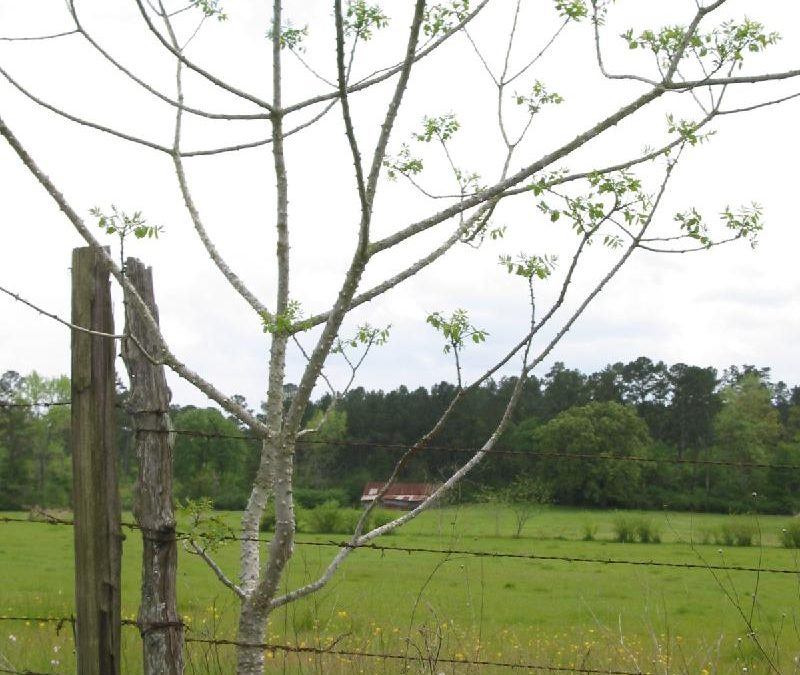
Hercules’ Club Tree
Unique Trees of North Texas:
Hercules’ Club
(Zanthoxylum clava-herculis)
By Jeremy Priest
This aptly name tree certainly deserves a spot on the “unique” list. Hercules’ club, which is also known as toothache tree, tickle tongue, pepperbark, or prickly ash, is part of the Zanthoxylum genus. The genus has many species with overlapping or similar common names, but only 3 other Zanthoxylum species grow in Texas (Texas Hercules’ club, lime pricklyash, and tickletongue). Many of the common names associated with this species refer to the stimulating nature of the bark and wood of the tree. The tree was historically used by Native Americans and early settlers to numb the mouth, hence the name toothache tree. The name Hercules’ club is easily noticed in the scientific name and fits the appearance of large specimens. When young, the tree develops sharp spines on the bark (not just at leaf nodes as with some other species) which are usually distributed throughout the trunk and branches. As the tree ages, the prickles develop corky, pyramidal bases and eventually lose their sharpness. These corky structures may eventually develop strong ridges as seen below. No matter the age, the trunk of this tree always looks like it could be fashioned into a fearsome weapon.
To identify Hercules’ club look for the distinct spines on the trunk and branches and pinnately compound leaves. Typically 5-19 leaflets, including a terminal leaflet, that are 0.5-4.5 inches long. Small greenish white flowers form in the spring at the tip of branches and seeds are shiny black but not very conspicuous. Don’t confuse Hercules’ club with devil’s walkingstick (Aralia spinosa), which grows straight up with very little branching and has doubly compound leaves. While the leaves may be similar to other compound leaved understory species such as sumac, or the spines similar to species such as honey locust, Hercules’ club is quite distinct and easily distinguished from all except other members of Zanthoxylum. Texas Hercules’ club is more common farther south and west and is a smaller stature tree with only 3-7 leaflets (5 is typical) 0.5-1.5 inch long with the entire leaf less than 4 inches long. Texas Hercules’ club also does not develop the strong corky bases on older prickles. The national champion Texas Hercules’ Club is in North Richland Hills with a height of 22 feet and a spread of 20 feet.
Hercules’ club is an understory tree that typically grows to less than 20 feet in height; however, it is only moderately shade tolerant and relies on establishing with limited competition. The seeds are popular with birds and remain viable after being eaten allowing the species to spread profusely along fencerows and transition zones. Another way it establishes with limited competition for light is to grow on poor sites such as upland, dry, or very sandy areas. In the Cross Timbers region, the overstory on these sites often consists of post oak and blackjack oak. As the tree is adapted to grow on harsh sites with low overall plant density, developing spines reduce wildlife browsing and helps Hercules’ club outcompete other vegetation. If the tree is to be planted, select a relatively dry area with good sunlight. Also remember that the spines on the trunk can be a concern but can be removed or the tips cut if needed. The sharp spines usually do not grow back as the bark develops.
Hercules’ club is native throughout the southeastern US extending from Florida to central Texas. It is tolerant of acidic and alkaline soils. This species also prefers well-drained or sandy soils and does not tolerate flooding. Some of the largest Hercules’ club in Arlington are found at the Southwest Nature Preserve, which is known for being a dry, upland site with some unusual species. There may also be Texas Hercules’ club at the nature preserve as some of the trees develop drastically different bark texture and smaller leaves. Another Arlington park where Hercules’ club is prevalent is Cliff Nelson, which has similar site conditions to the Southwest Nature Preserve. Fully grown the tree may reach 20 feet in height and 15-20 feet in crown diameter, with a trunk diameter of 8-12 inches in 30-40 years. Given the poor sites on which these trees are found they do grow somewhat quickly, as much as 1 foot per year in height. The largest Hercules’ club reported in Texas is in Nacogdoches County (East Texas) and has a height of 38 feet and a trunk diameter of nearly 20 inches, although trees in the Cross Timbers would not likely grow this large.
Sources
Vines, R. A. (1982). Trees of north Texas (Vol. 14). University of Texas Press.
